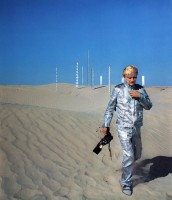HEINZ MACK
Tele-Mack
source: alltagskunstblog
Zwischen Himmel und Erde. Dort sind einige der Arbeiten Heinz Macks zu verorten. Dies gilt vor allem für die Stelen, die der Maler, Bildhauer und Lichtkünstler im öffentlichen Raum angebracht hat und die ihre Wirkung erst durch die Reflektion durch das Sonnenlicht vollständig entfalten.
Aufsehen sorgte hierbei vor allem sein Projekt, Ende der 1960er Jahre Lichtstelen in der tunesischen Sahara anzubringen. Die Wüste mit ihrer Sonnenkraft ist für Macks Arbeiten wie geschaffen. Denn es ihm geht unter anderem auch darum, die Kunstgegenstände durch das Licht zu immaterialisieren. Arbeiten im Meer und im Eis folgten ebenso.
Anlässlich seines 80. Geburtstages werden dem Mitbegründer der ZERO-Gruppe nun einige Ausstellungen gewidmet. Die größte ist derzeit, noch bis zum 10. Juli, in der Kunst- und Ausstellungshalle der Bundesrepublik Deutschland in Bonn zu sehen. Unter dem Namen Licht – Raum – Farbe sind dabei über 100 Werke ausgestellt, die von 1953 bis heute entstanden sind. Neben Malereien und Photographien seines Projekts in der Wüste sind dabei auch viele Skulpturen zu sehen, die durch Bewegung und den Einsatz von Licht und Farbe den Besucher zum Staunen und Hinterfragen einladen. Vor allem seine Rotorenarbeiten sind hier zu nennen. Einen kleinen Überblick gibt ein Video der Bundeskunsthalle in Form eines Austellungsrundgangs. Zudem ist auf der Homepage ein Video abrufbar, welches Mack selbst zu Wort kommen lässt und sein Schaffen und seine Ideen vorstellt.
Macks früheren Werke haben keinstenfalls an Wirkung verloren. Sein Utopiegedanke und sein Anspruch einer neuen Kunstform im Zuge des ZERO-Manifests erscheinen auch noch heute aktuell.
„Zero ist die Stille. Zero ist der Anfang. Zero ist rund. Zero ist Zero.“
.
.
.
.
.
.
source: mack-kunst
He was born in 1931 in Lollar, Hessen, attended the National Academy of Arts in Düsseldorf 1950-1953 (state examination) and in 1956 completed his studies in philosophy with the state examination at the University of Cologne.
Together with Otto Piene he founded the Gruppe ZERO in Düsseldorf in 1957.
One year later Mack participated in the Documenta II in Kassel and received the Art Award of the city of Krefeld.
Mack received the Premio Marzotto. 1964 – 1966 Mack had an atelier in New York and took part in the Documenta III.
In 1965 the artist was honoured with the 1st Prix arts plastiques of the 4th Biennale de Paris.
In 1970 he was appointed Professor and invited to lecture in Osaka (Japan) and becomes a member of the Academy of Arts in Berlin, which he remained until 1992.
At the XXXV Biennale in Venice in the same year, he represented Western Germany together with Uecker, Pfahler and Lenk.
1962-1968 and 1976 were times of large working expeditions into the Algerian desert and to the Arctic.
He received the first prize in the international competition Licht 79 in the Netherlands in 1979.
1992 brought the Great Culture Award from the Rheinischen Sparkassen-Verbandes.
In 2004 the artist was awarded the Große Bundesverdienstkreuz der Bundesrepublik Deutschland in recognition of his works and his commitment as a cultural representative.
In 2007 the Museum of Islamic Art in Pergamonmuseum in Berlin honoured him with a large exhibition which was visited by around 120,000 people.
Heinz Mack’s central artistic theme is light.
His sculptures and paintings are a medium for transporting light.
His complete abstract works are very diverse:
Sculptures from various materials, also monumental ones for outdoors, light pillars, light rotors, light reliefs and light cubes; paintings such as the Dynamischen Strukturen from the ZERO times from 1957-1966 and the increasingly large format and strongly coloured paintings as of 1991, the so-called Chromatischen Konstellationen.
Drawings, ink drawings, pastels, prints, and literary works, abstract photography with black and white hand prints and colour photography produced in the Slide-Sec process.
Design of public squares and rooms, also church interiors, stage settings and mosaics.
His works have been shown in around 300 solo exhibitions to this date.
Numerous books and catalogues as well as two films document his creativity.
Heinz Mack lives and works in Mönchengladbach and on Ibiza.
In 2008 the ZERO-Foundation is founded by the city of Düsseldorf. The Foundation receives the archives and numerous works of the artists Mack, Piene and Uecker. It is dedicated to research and supports documentations and exhibitions. Its activities focus on all the international artists associated with ZERO.
In 2009 the artist is awarded the Ehrenring (Ring of Honour) of the city of Mönchengladbach.
In 2010 he works on the autobiography “Mack – Leben und Werk /Life and Work”.
On the occasion of his 80th birthday in 2011, several national and international exhibitions are staged. Many catalogues and books are published in this context.
The artist is decorated with the “Große Verdienstkreuz mit Stern” (the Order of Merit) of the Federal Republic of Germany.
In 2012 he is awarded the “Preis der Kulturstiftung Dortmund”. Simultaneously an extensive exhibition is being shown at the Museum Ostwall located in the Dortmund U, an important creative arts center.
.
.
.
.
.
.
source: artblart
A founding member of Group Zero – an artist collective established in Düsseldorf in 1958 – Mack drafted the final version of his manifesto for Sahara Project in 1959. It was first published in Zero magazine in 1961, and subsequently republished and translated from German into French, Dutch, and English in 1967 for Mackazin, the artist’s journal-catalogue. Sahara Project, made in homage to Yves Klein, proposes placing large-scale sculptural works in remote areas of the world’s deserts, like mirages to be encountered by anyone coming upon them. One such location was the Sahara Desert, which was the main testing site for French nuclear weaponry after 1958. In 1967 Mack went on an expedition to the Sahara with the German public television station Westdeutscher Rundfunk (WDR), which led to two televised presentations of the project the following year – one for WDR and the other for Saarländischer Rundfunk. The popular weekly German magazine Stern presented the project in a feature spread in 1977.


